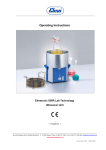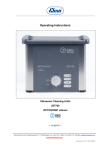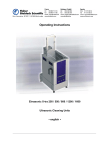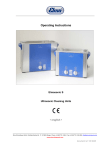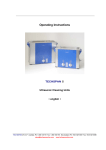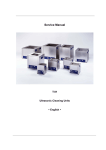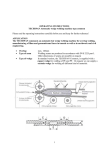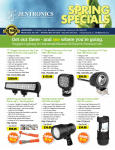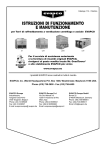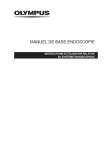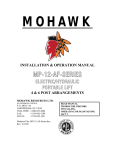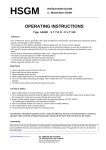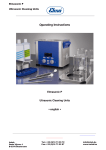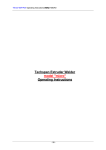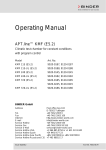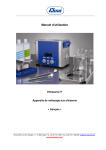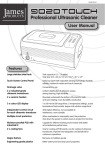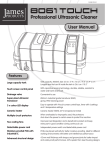Download Operating Instructions - Elma Ultrasonics Australia
Transcript
Operating Instructions Elmasonic X-tra XL 1200 / 1600 / 2700 TECHSPAN Ultrasonic Cleaning Units TECHSPAN Australia Ph- 1-800 148 791 E- [email protected] New Zealand Ph- 0800 603 603 E- [email protected] document ref. 104 9945 Contents Contents 1 General....................................................................... 4 2 Important safety warnings .......................................... 4 2.1 2.2 3 Ultrasonic cleaning factors ......................................... 8 3.1 3.2 4 Functioning .............................................................. 8 Ultrasonic cleaning process ..................................... 9 Product description ................................................... 10 4.1 4.2 4.3 4.4 4.5 4.6 4.7 4.8 4.9 4.10 4.11 4.12 4.13 5 Instructions for the use of the present manual.......... 4 Safety instructions for the use of the unit ................. 6 Elmasonic X-tra-pro product features ......................10 CE conformity .........................................................11 RFI Statement (European Union) ............................11 Delivered equipment ...............................................11 Optional accessories...............................................12 Technical details .....................................................13 Description of unit features .....................................15 Description of unit connections ...............................16 Description of ultrasonic tank ..................................17 Description Elma cleaning basket (accessory) ........18 Description hinged cover (accessory) .....................19 Description of operating elements ...........................20 Description and functions of the display ..................22 Before initial operation .............................................. 25 5.1 Unpacking and placement.......................................25 5.2 Connecting the unit to the mains .............................26 5.3 Basic settings in the display ....................................26 5.3.1 Setting of display language ..................................26 5.3.2 Setting of date / time ............................................27 5.3.3 Setting of the temperature measuring unit (°C / °F) ...............................................................27 5.3.4 Setting of display contrast ....................................28 6 Putting unit into operation ......................................... 29 6.1 6.2 6.3 6.4 6.5 6.6 2 Filling of the unit ......................................................29 Heating up of the cleaning liquid .............................30 Degassing of liquid in degas mode .........................31 Setting of ultrasonic frequency ................................32 Cleaning in ultrasonic mode sweep .........................32 Cleaning in ultrasonic mode pulse ..........................32 Contents 6.7 6.8 7 Setting of ultrasonic power ......................................33 Cleaning in ultrasonic phase control mode (only on units with 2-side sound) .............................34 Ultrasonic cleaning process...................................... 37 7.1 7.2 Immediate start-up of ultrasonic cleaning process...38 Temperature-controlled ultrasonic cleaning with automatic start-up of the cleaning process ..............39 7.3 Ultrasonic cleaning by user-defined cleaning programs ................................................................40 7.4 Timer-controlled ultrasonic cleaning ........................41 7.4.1 Setting of the timer start-up configuration ............41 7.4.2 Setting of the timer stop configuration ..................43 7.5 Placement of the cleaning items .............................44 7.6 Use of the Elma cleaning basket (accessory)..........44 7.7 After the cleaning ....................................................46 8 Cleaning media ........................................................ 47 8.1 Limitations of use of cleaners containing solvents ...47 8.2 Limitations on aqueous cleaners .............................48 8.3 List of recommended cleaning media ......................49 8.3.1 Industry and workshop .........................................49 9 Maintenance ............................................................. 50 9.1 9.2 9.3 9.4 9.5 Maintenance and care ............................................50 Service life of the ultrasonic cleaner ........................51 Repair .....................................................................51 Malfunctions............................................................52 Replacing the electronic unit ...................................53 10 Putting out of action and waste disposal ............... 54 11 Manufacturer's contact address............................. 54 3 General 1 General The present Operating Instructions are part of the delivered equipment. They must be ready for use at any time and remain with the unit in case of resale. We reserve the right to carry out technical modifications on the unit due to advanced development. An operating manual cannot take account of every conceivable use. An operating manual cannot take account of every possible use. Contact your dealer or the manufacturer for further information or in the event of problems which are not covered or not sufficiently covered in this operating manual. 2 Important safety warnings Carefully read and observe before initial operation Carefully read the present operating instructions and operate the electric unit in compliance with the instructions only. Exclusion of liability 2.1 Please observe any additional national safety regulations that may apply. The manufacturer cannot be held liable for any damages on persons, equipment or cleaning items caused by improper use against the instructions given in the present manual. The operator is responsible for the correct instruction of the operating staff. Instructions for the use of the present manual Warning symbols used in the present manual This symbol warns of the risk of injury caused by electricity. This symbol warns of the risk of injury caused by explosion and/or deflagration. This symbol warns of the risk of injury caused by hot surfaces and liquids. This symbol warns of the risk of hearing damage due to high sound pressure level noise emissions. This symbol warns of the risk of contusion of hand or fingers. This symbol warns of the risk of injury. This symbol warns of the risk of damage to the equipment. This symbol marks additional information. 4 Important safety warnings Signal words used in the present manual Danger The signal word Danger warns of a potential risk of serious injury and danger to life. Warning The signal word Warning warns of the risk of serious injury and heavy damage to the equipment. Caution The signal word Caution warns of the risk of light injury or damage to the equipment. Attention The signal word Attention warns of the risk of damage to the equipment. Mandatory signs on the ultrasonic cleaning unit and/or in the present operating instructions This mandatory sign serves as accident prevention measure and recommends the use of an ear protection device. This mandatory sign serves as accident prevention measure and recommends the use of goggles. This mandatory sign serves as accident prevention measure and recommends the use of protective gloves. 5 Important safety warnings 2.2 Safety instructions for the use of the unit Intended use User Operation of the unit by authorized and instructed staff only. Observe the instructions given in the manual. Check for damage Check unit and mains cable for transport damages. Do not operate the unit in case of visible damages! Mains connection For safety reasons, the present unit must be connected to a correctly grounded socket only. The technical details indicated on the nameplate must correspond with the available mains connection details, in particular those of the mains voltage and current connected value. Placement Prevention of electrical accidents Cleaning liquid Hot surfaces and liquids Hot steam Do not move filled unit Noise emission Sound transmission at physical contact 6 The present ultrasonic cleaning unit has been designed for the treatment of items immersed in a cleaning liquid only. It is not intended for the use in areas with potentially explosive atmosphere. Place the unit on a dry surface. The work area must be sufficiently ventilated to allow any vapours arising from the cleaning liquid to be carried off. Keep work surface, housing and operating elements dry. For purposes of filling, maintenance and care of the unit, in case of suspected humidity inside the unit or in case of malfunctions and after operation pull the mains plug. The unit must be opened by authorised specialised personnel only. The unit must be operated with aqueous cleaning media only. Flammable liquids must not be treated by ultrasound directly in the cleaning tank: risk of fire and explosion! Risk of burning and scalding! Depending on the operational period of the unit, unit surfaces, cleaning liquid, basket and cleaning items can heat up considerably. When the unit is operated at high temperatures open the unit cover (optional accessory equipment) with care. Hot steam can escape. Do not move the filled unit. Risk of tilting over and risk of damage to the unit. Move the unit only when it is empty. Use a fork lift and ensure that the fork is placed under the carrying trusses at the bottom of the unit. Ultrasonic units can emit annoying noise. Use a personal ear protection device when you keep within close distance to an operating ultrasonic unit, in particular when the unit is operating without cover at 25 kHz ultrasonic frequency. Do not reach inside the cleaning liquid or touch sound-carrying parts (tank, basket, cleaning items, etc.) during operation. Important safety warnings Maximum load cleaning basket Adjustment of unit feet The maximum load that may be put into the cleaning basket is 100 kg. Adjust the unit feet parallel to the overflow weir, fasten the counter nuts to ensure the maximum carrying capacity. 7 Ultrasonic cleaning factors 3 Ultrasonic cleaning factors 3.1 Functioning Today, cleaning by ultrasound is the most modern fine cleaning method. The electric high-frequency energy created by an ultrasonic generator is transformed into mechanical energy by piezoelectrical transducer systems and is then transmitted into the bath. This process creates millions of tiny vacuum bubbles which implode due to the variations of pressure caused by the ultrasonic activity. Highly energetic liquid jets are created. These jets remove dirt particles from surfaces and even from the smallest grooves and bores. Basically, the cleaning result depends on four factors: Mechanical energy Ultrasonic energy is probably the most important mechanical factor in the cleaning process. This energy must be transmitted through a liquid medium to the surfaces which are to be cleaned. The present Elmasonic unit is fitted with the innovative sweep function device: electronic oscillation of the sound field (sweep function) prevents the formation of zones of low performance in the ultrasonic bath. Cleaning media 8 For saponification and removal of the dirt particles a suitable cleaning agent is required. We have a large range of cleaning media on offer. Temperature The effect of the cleaning medium is improved by the optimised temperature of the cleaning liquid. Cleaning period The cleaning period depends on the degree and the kind of contamination and on the correct selection of ultrasonic energy, cleaning agent and temperature. Phase control Optionally available device for the control of the cavitation fields (on units with 2-side sound). The device allows an additionally optimized sound field distribution, stationary sound pressure maxima and minima are prevented. Damage through cavitation and “surface shadows” on particularly sensitive surfaces are avoided. The surfaces are treated thoroughly and gently. Ultrasonic cleaning factors 3.2 Ultrasonic cleaning process 1. Fill the ultrasonic tank with water and cleaning concentrate (Section 6.1). 2. Heat up the cleaning liquid, if required for the intended cleaning application (Section 6.2). 3. Degas the cleaning liquid – operation in degas mode at 37 kHz or rather 45 kHz (Section 6.3). 4. Select the required ultrasonic frequency depending on the cleaning task: low frequency for intensive cleaning or high frequency for gentle cleaning (Section 6.4). 5. Activate the ultrasonic sweep mode – if required for the intended cleaning application (Section 6.5). 6. Activate the ultrasonic pulse mode – if required for the intended cleaning application (Section 6.6). 7. On units with 2-side sound: switch on the ultrasonic mode phase if required for the intended cleaning application (section 6.8.). 8. Switch on the ultrasound (manual or automatic start-up) (Section 7.1 and Section 7.2). 9. Put the cleaning items into the cleaning bath (e.g. in the basket) (Section 7.5). 10. Rinse if necessary (Section 7.6). 9 Product description 4 Product description 4.1 Elmasonic X-tra-pro product features ultrasonic tank made of extremely cavitation-proof stainless steel (V4A) inclined tank floor to facilitate the draining of the cleaning liquid skimming ledge for the optional surface skimming, e.g. of oil bottom scouring of removed sediments (optional) sandwich-type performance transducer systems two ultrasonic frequencies, switchable in one unit 25 kHz or 45 kHz, for either intensive or gentle cleaning user-friendly operation by keys and display; 5 display languages available setting and starting of up to 5 user-defined cleaning programmes timer for the programming of day controlled or time controlled cleaning start, and user-defined switch-off activatable sweep mode for a continuous shifting of sound field maxima, guarantees a more homogeneous sound field distribution in the bath activatable pulse mode for an intensified ultrasonic cleaning power for tenacious contaminations; also the operational readiness of the unit (cavitational threshold reached) after an exchange of the cleaning liquid or after an exchange of baskets is optimized (through a shortening of the cleaning periods) activatable degas mode for the efficient degassing of the cleaning liquid and for spezial laboratory cleaning tasks Phase control mode activatable (on units with 2-side sound) for an optimized sound field distribution, in particular for the cleaning of sensitive surfaces manual setting of ultrasonic intensity heating with temperature control (30°C – 80°C) temperature-controlled ultrasonic operation: ultrasound starts automatically as soon as the preset temperature is reached automatic safety switch-off after 12 h operation to prevent unintended permanent operation automatic safety switch-off at 90 °C to protect the cleaning items against excess temperatures 10 Product description 4.2 level monitoring with integrated automatic safety switchoff in case of too low liquid level housing made of V2A stainless steel drain duct made of V2A stainless steel, mounted to the unit rear connection ducts for the optional connection of peripheric equipment (e.g. filter-pump system, oil separator) connection to an external control system possible (PLC / PC) CE conformity The present ultrasonic cleaning unit complies with the CE marking criteria with regard to the EMC directive 2004/108/EG, and to the low voltage directive 2006/95/EG. The declaration of conformity is available from the manufacturer. 4.3 RFI Statement (European Union) This is a Class A product. Please note: This equipment has been approved for business purposes with regard to electromagnetic interference. In a domestic environment this product may cause radio interference in which case the user may be required to take adequate measures. For this please contact your supplier or the manufacturer of the unit. 4.4 Delivered equipment Ultrasonic cleaning unit Operating Instructions 11 Product description 4.5 Optional accessories Stainless-steel basket (operation with oscillation and lift) Removable stainless-steel cover Noise protection cover, hinged Unit available with oscillation (operation possible with closed noise protection cover); retrofitting by the manufacturer only Oil separator Pump filter aggregate Transducers mounted to more than one tank wall (2-side sound with optional phase control mode, or 3-side sound) Blowing station (compressed air) Showering device (hand shower) Ball valve extension (filling) Ball valve extension (drain) Protection screen for tank floor to retain cleaning items 12 Product description 4.6 Technical details XL 1200 XL 1600 XL 2700 140 180 300 Tank service dimensions W/D/H (ca. mm) 520/450/445 720/400/515 720/600/545 Unit outer dimensions W/D/H (ca. mm) 940/1040/1050 1180/990/1050 1180/1170/1050 125 135 155 460/375/320 660/325/380 Basket loading max. (ca. kg) 100 100 100 Ball valve drain 1“ 1“ 1 ¼“ Ball valve filling 1/2“ 3/4“ 3/4“ Emergency overflow 1“ 1 ¼“ 1 ¼“ Overflow basin 1“ 1“ 1“ Surface skimming ½“ ½“ ½“ Bottom scouring ½“ ½“ ½“ Connection PFE (suction side) 1“ 1“ 1 ¼“ 3 x 400V/ N/PE 3 x 400V/ N/PE 3 x 400V/ N/PE 25 / 45 25 / 45 25 / 45 Tank service capacity (ca. L) Weight (ca. kg) Basket (accessory) inner dimensions W/D/H (ca. mm) Mains voltage (Vac) Ultrasonic frequency (kHz) 660/525/380 Power consumption total (W) Bottom sound 7800 10700 13500 2-side sound 9000 12700 14500 3-side sound 8800 12700 14500 Bottom sound 2000 2000 3000 2-side sound 3200 4000 4000 3-side sound 3000 4000 4000 Ultrasonic power effective (W) 13 Product description XL 1200 XL 1600 XL 2700 Ultrasonic peak power max*** (W) Bottom sound 2-side sound 3-side sound Heating power (W) Sound pressure level 8000 8000 12000 12800 16000 12000 16000 5800 W 8700 W 10500 W 93 / 72 93 / 80 91 / 79 80 / 67 84 / 72 84 / 72 107 / 105 107 / 107 107 / 105 16000 16000 25 / 45 kHz (LpAU) ** dB Sound pressure level 25 / 45 kHz (LpAU) *** dB Ultrasound level 25 / 45 kHz (LpZ) *** dB * The signal form of the waves results in a factor 4 for the ultrasonic peak maximum ** Max. sound pressure level measured in 1 m distance, without basket and noise protection cover *** Sound pressure level measured in 1 m distance, with basket and noise protection cover 14 Product description 4.7 Description of unit features E A B D C Fig. 4.7 Unit front view A Operating panel controls the unit functions; description see Section 4.12. B Electronic unit with performance electronics, easy to exchange for service or repair purposes C Unit feet height adjustable D Ball valve extension for the control of the filling ball valve (optional) E Noise protection cover hinged flip-top cover (optional) 15 Product description 4.8 Description of unit connections L A B K J I D C H E F G Fig. 4.8. Connections on unit rear 16 A Feed duct surface skimming B Cable feedthrough oscillation C 2-way ball valve tank drain D H Pump filter unit connection, suction side E Mains supply F Interface SPC G Interface SPC H Feedthrough hand shower I Drain bottom scouring J Connection 2-way ball valve filling (optional) K Drain of overflow basin e.g. to optional connection to pure water unit, oil separator or cascade H Emergency overflow Product description 4.9 Description of ultrasonic tank B A C B D E F F G F Fig. 4.9. Ultrasonic tank A Ultrasonic tank made of cavitation-proof stainless steel. The tank floor is inclined towards the drain duct. The transducer elements are mounted underneath the tank floor. Depending on the model, transducer elements are also mounted to the tank sides (on units with 2-side sound or 3-side sound) B Support brackets for Elma cleaning basket 4x C Level switch for liquid, switches the unit off when the level of the liquid falls below the minimum filling level D Heating elements E F Protecting bars for heating elements Overflow basin takes oils etc. skimmed off the surface, connection to optional peripheric units possible (e.g. filter pump system, oil separator); the upper edge of the overflow weir also marks the optimum filling level for operation 17 Product description 4.10 Description Elma cleaning basket (accessory) C D E A B Total load max. 100 kg Fig. 4.10 Cleaning basket A Cleaning basket stainless-steel mesh (observe max. loading!) B Basket support device detail C Eye for lift detail For further information see Section 7.6. 18 Product description 4.11 Description hinged cover (accessory) C B A D Fig. 4.11 Noise protection cover (hinged) A Noise protection cover (hinged) B Sealing C Handle D Hinge Safety instructions on the use and operation of the noise protection cover Risk of scalding with open unit cover! CAUTION When the unit is operated at high temperatures hot steam can escape when the unit cover is opened. Condensation water can drip off. Open the cover with care and step back from the unit. 19 Product description Risk of hand injury when mounting or adjusting the hinges of the noise protection cover. CAUTION The hinges are subject to a high pretension. The hinges must be adjusted or removed by instructed authorized personnel only. Risk of injury caused by opening and closing of the sound protection cover. CAUTION The sound protection cover opens and closes self-activatedly in the final opening / closing stage. Hold the handle until the final position is reached. 4.12 Description of operating elements C A B E G F D L H I J K M Fig. 4.10 operating panel 20 A Key on/off switches the unit on and off. The LED in the key is lighted red (stand by) when the unit is connected to the mains and switched on by the main switch (M). As soon as the key is activated the operating panel is ready for operation and the LED in the key lights up green. B Key heating for switching on the heating control. The LED in the key turns green as soon as the heating is switched on. C Key temperature preselection temperature can be set by 5°C steps between 30° and 80°C. The actual setting is indicated in the display (set). D Navigation keys, keys for navigation in the display, description see Section 4.13. E Display showing the unit settings. Product description F Key setting of ultrasonic intensity by 10% steps. The actual setting is indicated in the display. G Key frequency for the selection of the ultrasonic frequency. The lower frequency is for intensive cleaning tasks; the high frequency is for gentle cleaning tasks (see also Section 6.4). The actual setting is indicated in the display. H Key ultrasonic mode degas for the degassing of fresh cleaning liquid. The LED in the key turns green as soon as this mode is activated. The degas mode cannot be operated simultaneously with the sweep or pulse modes. I Key ultrasonic mode sweep, for the continued shifting of the sound field maxima, guarantees a more homogeneous sound field distribution within the cleaning bath. The LED in the key turns green as soon as this mode is activated. The sweep mode cannot be operated simultaneously with the degas or pulse modes. J Key ultrasonic mode pulse for an increased power for difficult cleaning tasks. The LED in the key turns green as soon as this mode is activated. The pulse mode cannot be operated simultaneously with the degas or sweep modes. K Key ultrasound to switch on the ultrasonic operation. The LED in the key turns green as soon as the ultrasound is started (permanent green light for manual start-up, blinking green light for temperature-controlled start-up). Description see Section 7.1 and Section 7.2. L Key time for the setting of the cleaning time Possible settings for short-term operation: 1, 2, 3;…10; 15, 20, 25…60; 70, 80,90…120 min (automatic switch-off). Permanent operation ∞ for continued ultrasonic activity. Here, the unit must be switched off by hand. For reasons of safety, the unit is automatically switched off after a permanent operation of 12 hours. M Main switch 0 – 1 switches the unit on and off; can be secured against unintended switching by means of a padlock (e.g. during repair and maintenance works) 21 Product description 4.13 Description and functions of the display Standard display during operation The display is divided into 4 sections. During operation of the unit, up to 5 parameters are indicated, which can be set by the relevant operating keys. The 4 navigation keys and the keys temperature, heating, frequency or power control the displayed parameters: The main menu is opened by pressing any navigation key. By pressing the keys temperature, heating, frequency and power the respective display section is shown in full screen (context menu). 4 seconds after the last key setting the display automatically returns to the standard display. A B C D Fig. 4.11.1 Standard display A Cleaning time: set time (upper value); remaining time (lower value); ∞ indicates continued operation. B Ultrasonic frequency (upper value); ultrasonic mode sweep, degas, pulse, phase (lower indication). The mode is indicated only when activated. C Set temperature (upper value); actual temperature (lower value) D Ultrasonic power in % How to start the main menu To start the main menu press one of the navigation keys below the display (see Fig. 4.12.D). The following display appears: E Fig. 4.11.2 F 22 G H I Product description E The main menu shows 3 functions (submenus) to select from. The activatable function is marked black. Load program: starts one of the user-defined programs. Up to 5 cleaning programs can be set and started (see also Section 7.3). Save program: sets and saves a new cleaning program (see also Section 7.3). Settings: change the following parameters: date/time – timer – display contrast – temperature unit – language – service (only for service points) – phase control (optional). How to navigate in the main menu To navigate in the main menu press the required navigation key below the display sections F – I. F Escape: By pressing the navigation key below this display section you return to the previous operation level. G Up: By pressing the navigation key below this display section you increase the value of the respective parameter; you also navigate within the present menu. H Down: By pressing the navigation key below this display section you reduce the value of the respective parameter; you also navigate within the present menu. I How to enter a submenu Enter: By pressing the navigation key below this display section you acknowledge the respective setting. Use the navigation keys below the arrows in the display (Section 4.13.2.G/H) to select the required option (marked black) and start the selected submenu by pressing the navigation key below the display section Enter (Fig. 4.13.2.I). The available submenus are listed in the display (Fig. 4.13.3) dargestellt. 30 seconds after the last setting in the main menu the display automatically returns to standard display. 23 Menu structure Product description Abb. 4.11.3 Menu structure of control panel 24 Before initial operation 5 Before initial operation 5.1 Unpacking and placement Unpacking Check for transport damages Workplace Please keep the original packing for possible later service purposes or dispose of it in compliance with the relevant waste disposal regulations. You can also return the packing to the manufacturer or to your supplier. Check the unit for possible transport damages before initial operation. In case of visible damage do not operate the unit. Contact your supplier and the forwarding agent. For operation place the unit on a stable, even and dry surface. The surface must be resistant to any cleaning chemicals that might be used. Adjust the unit feet parallel to the overflow weir, fasten counter nuts! Ensure that the workplace is sufficiently ventilated! Risk of electrocution due to humidity inside the unit! Protect the unit from entering humidity. DANGER The unit inside is splash-proof. Keep workplace and casing dry in order to prevent electrical accidents and damages on the unit. Ambient conditions The following requirements are mandatory for the safe operation of the unit: Allowed ambient temperature during operation: +5°C - +40°C Allowed relative humidity of air during operation: max. 80% Admissible ambient temperature change for the unit and the bath liquid: non-condensing (no formation of condensation water at the unit surfaces). Details are available from the manufacturer. In-door operation only 25 Before initial operation 5.2 Connecting the unit to the mains Required mains conditions Ensure that the local connection details correspond to the data indicated on the nameplate! See also Technical details (Section 4.6.) Connect mains cable Connect the unit to a grounded shockproof socket only! The mains plug must be connected to an easily accessible socket only, as it serves as interrupted device! 5.3 Basic settings in the display Set the following basic parameters in the display. Repeat the procedure for later adjustments. The required basic settings are done in the menu settings. How to proceed 1. Switch on the unit (on/off): The display shows the standard display (Abb. 4.13.1). 2. Start the main menu in the display by pressing one of the navigation keys below the display (Fig. 4.12.D). The display now shows the main menu (Fig. 4.13.2). 3. Use the navigation keys below the arrows in the display (Fig. 4.13.2.G/H) to select the submenu settings and press Enter (Abb. 4.13.2.I). The display now shows settings. 5.3.1 Setting of display language There are 5 display languages available to select from: German – English – French – Spanish – Italian. To change the display language proceed as follows: How to proceed 1. Carry out steps 1 - 3 described in Section 5.3. 2. Use the navigation keys to select the menu task language and acknowledge with Enter. 3. Use the navigation keys to select the requested language and acknowledge with Enter. Fig. 5.3.1 Language menu 4. Use the navigation key ESC to leave this menu. 26 Before initial operation 5.3.2 Setting of date / time Once the date has been set, it will be automatically adjusted. Observe the local time for setting the time. How to proceed 1. Carry out steps 1 - 3 described in Section 5.3. 2. Use the navigation keys to select the menu task date / time and acknowledge with Enter. 3. The first activated input box is the box for the year. Change the year by means of the +/- keys if required and acknowledge with Enter. This automatically activates the input box month. 4. Enter the data for month and time likewise. 5. Use the navigation key ESC to leave this menu. If you have entered wrong data, press ESC to leave the menu and start the setting again. Fig. 5.3.2 Menu for setting date / time (example) 5.3.3 Setting of the temperature measuring unit (°C / °F) The display can indicate the temperature either in degrees Celsius (°C) or Fahrenheit (°F). How to proceed 1. Carry out steps 1 - 3 described in Section 5.3. 2. Use the navigation keys to select the menu task temperature unit and acknowledge with Enter. 3. Use the +/- keys to select the requested measuring unit and acknoledge with Enter. 4. Use the navigation key ESC to leave this menu. Fig. 5.3.3 Menu for setting temperature measuring unit 27 Before initial operation 5.3.4 Setting of display contrast Depending on the ambient lighting conditions it may be required to change the display contrast. 1. Carry out steps 1 - 3 described in Section 5.3. 2. Use the navigation keys to select the menu task display contrast and acknowledge with Enter. 3. Use the +/- keys to change the contrast and acknowledge with Enter. 4. Use the navigation key below ESC to leave this menu. Fig. 5.3.4 Display contrast menu (example) 28 Putting unit into operation 6 Putting unit into operation 6.1 Filling of the unit Pull the mains plug Caution! For reasons of safety always pull the mains plug for filling the cleaning liquid. Shut the drain duct Observe filling level Shut the drain duct before you fill the tank. Fill the cleaning tank with a sufficient quantity of a suitable cleaning liquid before switch-on. The recommended filling level is indicated by the upper edge of the overflow weir (sehe fig. 4.9.F.). The emergency overflow (fig. 4.9.G.) must be kept clear – do not close the opening. Fill the tank with aqueous cleaning media only: Ensure that the chosen cleaning agent is suitable for treatment in an ultrasonic bath and observe the instructions on dosage and the compatibility of the material. All flammable cleaning media are prohibited for use in an ultrasonic bath. Please observe the safety warnings in Section 8 (Cleaning media). Allowed cleaning agents Prohibited cleaning agents Risk of fire and explosion! DANGER Never use flammable liquids or solvents directly in an ultrasonic cleaning bath. Use the cleaning chemicals listed in Section 8.3. Ultrasonic activity increases the vaporisation of liquids and creates a very fine mist which can catch fire on any ignition source. Observe the instructions on limitations of use given in Section 8.1. ATTENTION Risk of damage to the ultrasonic tank! Do not use any acid cleaning agents (pH value < 7) directly in the stainless steel tank if the cleaning items or the contamination of the cleaning items contain halogenides (fluorides, chlorides or bromides). The same applies to NaCl solutions. Use the cleaning chemicals listed in Section 8.3. The stainless steel tank can be destroyed by crevice corrosion in a very short time. Substances that cause crevice corrosion can be contained in household cleaners. Observe the instructions on limitations of use given in Section 8.2. For queries please contact the manufacturer or your supplier. Danger of damage to the transducer system! ATTENTION Fill no liquid > 60°C and < 10°C in the ultrasonic tank. 29 Putting unit into operation 6.2 Heating up of the cleaning liquid Heat up the cleaning liquid depending on the kind and degree of contamination of the cleaning items to assist the cleaning effect. We recommend that you use one of the Elma unit covers (accessory) to accelerate heating up and to avoid energy losses. You may also switch on the ultrasound to further speed up the heating process. The ultrasonic energy is transformed physically into heat. Therefore, low preset temperatures may be exceeded during ultrasonic operation. In order to avoid unintended heating over the required temperature due to the additional ultrasonic energy, set the temperature at the lowest possible value for the cleaning task at hand. High temperatures! Risk of burning and scalding! CAUTION Cleaning liquid, ultrasonic tank, housing, cover, basket and cleaning items may heat up considerably depending on the temperature inside the bath. Do not reach inside the bath! Wear protective gloves to handle the unit and basket! How to proceed 1. Press the key on/off (Fig. 4.12.A), the green LED in the key is lighted. 2. Use the +/- keys (Fig. 4.12.C) to set the required cleaning temperature (set value). The display shows the set temperature as numbers (Fig. 6.2.A) and in addition by a small black arrow at the mercury column symbol (Fig. 6.2.C). The actual temperature is also indicated as numbers (Fig. 6.2.B) and by a small black symbolized mercury bar (Fig. 6.2.D). 3. Press the key heating (Fig. 4.12.B), the green LED in the key is lighted. 4. The unit starts heating immediately. 5. As soon as the set temperature is reached the heating automatically switches off. A B Fig. 6.2 Display temperature setting (example) 30 C D Putting unit into operation The ultrasonic energy can heat up the cleaning liquid over the set temperature. Particularly low set temperatures (e.g. 30°C or 40°C) can easily be exceeded. 6.3 Degassing of liquid in degas mode Freshly mixed cleaning liquids are saturated with air which reduces the cleaning effect of the ultrasonic activity. Operating the ultrasound over a period of several minutes before the cleaning process will eliminate the tiny air bubbles in the liquid. How to proceed 1. Activate the ultrasound at the key ultrasound (Fig. 4.12.K). The green LED in the key is lighted. 2. Press the key degas (Fig. 4.12.H). The green LED in the key goes on. The display indicates the degas mode (Fig. 6.3.A). 3. Use the selector key frequency (Fig. 4.12.G) to select 45 kHz. The display now indicates the selected frequency (Fig. 6.3.B). 4. Press the key ultrasound to start the ultrasonic activity. A B Fig 6.3 Display ultrasonic operating mode and frequency (example) After approx. 5 to 10 minutes the cleaning liquid is degassed. Switch off the ultrasound. You can carry out the degassing during the heating process. 31 Putting unit into operation 6.4 Setting of ultrasonic frequency The present unit can be operated at 2 different ultrasonic frequencies. The following frequencies are available: 25 kHz For the removal of coarse and tenacious contaminations, and for the precleaning of robust surfaces. 45 kHz For the fine cleaning, and for the removal of contaminations from sensitive surfaces. How to set the ultrasonic frequency Press + or – at the key frequency (Fig. 4.12.G). The display shows the set frequency (Fig. 4.13.1.B). 6.5 Cleaning in ultrasonic mode sweep The sweep mode causes a permanent shifting of the sound pressure maxima and therefore leads to a more homogeneous sound field distribution within the cleaning bath. We recommend to activate this mode e.g. if the cleaning items fill the complete tank and/or if the cleaning basket carrying the cleaning items is not connected to a manual or automatic oscillation device. How to switch on sweep Press both the key ultrasound and the key sweep (Fig. 4.12.I). The green LED in the key indicates that the unit is operating in sweep mode. The display indicates sweep mode. The sweep mode cannot be activated simultaneously with degas or sweep. 6.6 Cleaning in ultrasonic mode pulse pulse is a special feature which intensifies the ultrasonic cleaning effect. This is particularly useful for the removal of tenacious contaminations. In addition, it takes less time for the unit to be ready for operation after an exchange of the cleaning liquid or when a new basket has been inserted (the unit is ready for operation when the cavitation threshold is reached so that the ultrasonic effect within the cleaning liquid is greatest). This shortens the overall cleaning period. There are certain operating phases with a reduced ultrasonic cleaning effect due to physical reasons. In particular when the cleaning liquid has been exchanged or when a new basket with cleaning items has been inserted the cleaning effect is temporarily reduced. An efficient ultrasonic cleaning cannot be guaranteed during these phases. 32 Putting unit into operation The pulse mode keeps these phases to a minimum, which leads to an optimum usability even with high throughput rates. How to activate the pulse mode Press both keys ultrasound and pulse (Fig. 4.12.J). The green LED in the key indicates the operation in pulse mode. pulse can be switched on or off as required during operation. The display indicates pulse mode. The pulse mode cannot be activated simultaneously with degas or sweep. NOTE Cleaning items with sensitive surfaces may be adversely affected by a combination of pulse and 25 kHz. Please treat sensitive items at 25 kHz plus pulse for short periods only. Also, the sound-giving surface of the cleaning tank is subject to a higher degree of cavitational erosion. 6.7 Setting of ultrasonic power For the cleaning of sensitive surfaces we recommend to reduce the ultrasonic power. You can adjust the ultrasonic power by 10% steps. How to change the ultrasonic power Press + or – at the key power (Fig. 4.12.F). The display shows the set ultrasonic power (Fig. 4.13.1.B). Fig. 6.7 Display ultrasonic power (example) 33 Putting unit into operation 6.8 Cleaning in ultrasonic phase control mode (only on units with 2-side sound) Advantages Operating principle The phase control mode provides an improved sound field distribution and prevents the forming of stationary sound pressure maxima and dead zones / ultrasonic shadow zones in the cleaning liquid. This helps to obtain uniform cleaning results and to protects cleaning items with sensitive surfaces against damage caused by cavitation. On a model with 2-side sound the ultrasonic transducers are mounted opposite to each other to the two long sides of the ultrasonic tank. The sound field created between the two sound-giving walls moves horizontally through the tank. The speed per cycle through the tank can be adjusted between 60 sec and 180 sec /360°. Simply put, the effect of controlled cavitation fields can be compared to the rotating cleaning brushes in a car wash. Intensive ultrasonic zones, generated in rapid succession, are continuously shifted through the cleaning liquid and thus across the surfaces of the cleaning items. The sound field moves from the front of the tank towards the back. How to proceed Position the cleaning items, e.g. sensitive wafers, displays, optical lenses, etc., standing vertically and perpendicular to the long tank sides (sound-giving surfaces). 1. Carry out steps 1-3 described in Section 5.3. 2. Use the navigation keys to select the menu item phase shift speed and acknowledge with Enter (fig. 6.8.1.). Fig. 6.8.1. Menu settings 34 Putting unit into operation 3. The phase shift speed display appears (fig. 6.8.2.). Use the keys “+” and “-“ to select the speed per cycle between 60 sec. and 180 sec. / 360° and acknowledge with Enter. Fig. 6.8.2 Phase shift speed contect menu 4. The menu settings reappears. Use the navigation keys to select the menu item phase control and acknowledge with Enter (fig. 6.8.3.) Fig. 6.8.3. Menu settings 5. The phase control display appears (fig. 6.8.4.). In the context menu phase control select the item Status: activated and acknowledge with Enter. Fig. 6.8.4. Phase control context menu 6. Now the standard display appears. The phase control mode is now set as standard mode. In order to go back to the normal ultrasonic operating mode select the menu item Status: deactivated in the phase control context menu (fig. 6.8.4.). 35 Putting unit into operation There are two ultrasonic modes available: normal mode and phase control mode. Each of the two modes can be set as standard operating mode. If one of the keys degas, sweep or pulse is pressed during phase control operation, the phase control mode is deactivated until the degas, sweep or pulse mode is stopped. 36 Ultrasonic cleaning process 7 Ultrasonic cleaning process There are several ways to start the cleaning process (see Section 7.1 – 7.3.) Please observe the following instructions before starting the ultrasonic cleaning process. Risk of scalding by hot surfaces and cleaning liquid! CAUTION Ultrasonic energy is physically transformed into heat. The unit and the cleaning liquid in the tank heat up during ultrasonic operation even with the heating switched off. During permanent operation with cover temperatures exceeding 60°C can be reached. During permanent operation with cover and heating temperatures exceeding 80°C can be reached. Do not reach inside the bath. If necessary touch unit and basket with protecting gloves! Ultrasonic units can produce annoying sounds. CAUTION Wear personal ear protection devices when working close to an ultrasonic unit which is operated without cover. Use a personal ear protection device when you work on or close to an operating ultrasonic unit. CAUTION ATTENTION Sensitive surfaces may be adversely affected by ultrasound during prolonged periods of ultrasonic treatment, in particular at lower ultrasonic frequencies. Ensure that sensitive surfaces are exposed to ultrasonic activity for a suitable period only. If in doubt check the cleaning progress regularly and observe the state of the surface material. Ultrasonic energy is physically transformed into heat. ATTENTION The unit and the cleaning medium in the tank heat up during ultrasonic operation even with the heating switched off. During permanent operation with cover temperatures exceeding 60°C can be reached. For the cleaning of temperature-sensitive items please take into consideration the heating-up of the cleaning medium. 37 Ultrasonic cleaning process CAUTION Do not reach into the cleaning liquid during ultrasonic operation. Risk of damage to cell walls, in particular of cells of the skeleton and the joints. The operator is responsible for the inspection of the cleaning result and for the continuous inspection of the cleaning items during ultrasonic treatment to prevent damages from the cleaning items. 7.1 Immediate start-up of ultrasonic cleaning process Set the cleaning period Set the required cleaning time by means of the key „+“ (Fig.4.12.F). Fig. 7.1.1 Display cleaning time (example) Short period operation For short period operation set the cleaning period between 1 and 120 min (Fig.4.12.L). The display indicates the set cleaning time in minutes : seconds (see Fig. 7.1.2.A). Once the unit is operating the remaining cleaning time is indicated in minutes : seconds (see Fig. 7.1.2.B). A B Fig. 7.1.2 Standard display (example) As soon as the preset period has run down the ultrasound is automatically switched off. Continued operation For longer periods of ultrasonic treatment select the continued operation mode (∞). The display shows ∞. 38 Ultrasonic cleaning process In this operating mode there is no automatic switch-off. The ultrasound must be switched off by the operator by pressing the key ultrasound (Fig. 4.12.K). How to start the ultrasound Start the ultrasonic activity by pressing the key ultrasound (Fig. 4.12.K). For reasons of safety (unintended permanent operation), the unit is automatically switched off after 12h of permanent operation. The unit can be switched back on immediately. During continued operation the ultrasound may heat up the medium to temperatures exceeding the set value even when CAUTION the heating is not switched on. In order to prevent unnecessary heating of the cleaning medium by ultrasound, particularly with low preset temperatures, switch on the ultrasound during the cleaning process only (exceptions are degassing and stirring of the cleaning bath during heating up). 7.2 Temperature-controlled ultrasonic cleaning with automatic start-up of the cleaning process Functioning Elmasonic XL units are equipped with an additional temperature-controlled cleaning function. The cleaning process is automatically started as soon as the required bath temperature is reached. How to proceed 1. Press the key on/off (Fig. 4.12.A), the green LED in the key goes on. 2. Set the required cleaning temperature by pressing the keys +/- (Fig. 4.12.C). 3. Press the key heating (Fig. 4.12.B), the green LED in the key goes on. 4. Set the required cleaning period by pressing the keys +/(Fig. 4.12.L). 5. Press the key ultrasound and keep it pressed (> 2 sec.): The unit starts heating. The display indicates the set time as blinking value (not during permanent operation). The green LED in the key ultrasound is flashing. As soon as the set temperature is reached the ultrasound is switched on and keeps operating over the preset cleaning period. 39 Ultrasonic cleaning process 7.3 Ultrasonic cleaning by user-defined cleaning programs You can save and start up to 5 user-defined cleaning programs. The programs are saved and activated from the main menu. Saving a new program stores the cleaning parameters that are presently set in the operating panel. How to save a cleaning program 1. Select the requested cleaning parameters (frequency, cleaning time, etc.) that you want to save. 2. Press any one of the navigation keys below the display (Fig. 4.12.D) to open the main menu. The display shows the main menu (Fig. 4.13.2). 3. Use the navigation keys below the arrows in the display (Fig. 4.13.2.G/H) to select the menu task save program and acknowledge with Enter (Fig. 4.13.2.I). The display now shows save program. 4. Use the navigation keys to select the requested program space (1 - 5). 5. Press Enter to save the program. 6. The display now shows program has been saved. How to start a saved cleaning program Saved user-defined cleaning programs can be started as follows: 1. Press any one of the navigation keys below the display (Fig. 4.12.D) to open the main menu. The display shows the main menu (Fig. 4.13.2). 2. Use the navigation keys below the arrows in the display (Fig. 4.13.2.G/H) to select the menu task load program and acknowledge with Enter (Fig. 4.13.2.I). The display now shows load program. 3. Use the navigation keys to select the requested program (1-5). 4. Press Enter to select the program. 5. The display shows the stored parameters. 6. Press the key ultrasound (Fig. 4.12.K) to start the program. How to rewrite saved cleaning programs Saved programs can be replaced (rewritten) by new programs as often as required. 1. Select the requested cleaning parameters (e.g. frequency, cleaning time, etc.) that you want to save. 2. Proceed as described above in the section How to save a cleaning program. 40 Ultrasonic cleaning process 7.4 Timer-controlled ultrasonic cleaning You can define times and dates for the start-up and/or termination of cleaning processes. Before you set the timer, ensure that date and time are correctly set in the menu settings > date / time, as these values serve as reference data. If they are incorrect, set the correct date and time first (see Section 5.3.2). If the set termination time is more than 12 h after the start-up time, the unit is automatically switched off after 12 hours of permanent operation (safety switch-off). 7.4.1 Setting of the timer start-up configuration Set the requested parameters in the menu settings > timer. How to proceed 1. Use the navigation keys below the arrows in the display (Fig. 4.13.2.G/H) to select the menu task settings and acknowledge with Enter (Fig. 4.13.2.I). The display shows settings. 2. Use the navigation keys to select the menu task timer and acknowledge with Enter. 3. Use the navigation keys to select timer ON and acknowledge with Enter. Fig. 7.4.1.1 Timer menu 41 Ultrasonic cleaning process How to set the mode OFF Set the operating mode in which you want the unit to start. The following options are available: The start configuration is disabled. one time The start configuration is carried out one time as soon as the set time is reached; then it is set to „OFF“. Mon-Fri The start configuration is carried out from Monday to Friday. daily The start configuration is carried out every day. 4. Use the navigation keys to select mode and acknowledge with Enter. The selector automatically moves to function. Fig. 7.4.1.2 Start configuration menu (example) How to set the function heating heat + ultrasound ultrasound Now select the function(s) that you want to start. Only the heating is switched on. Heating and ultrasound are switched on. Only the ultrasound is switched on. 5. Use the navigation keys to select function and acknowledge with Enter. The selector automatically moves to time. How to set the time Now set the start time: 6. Use the navigation keys to select the start hour and acknowledge with Enter. 7. Use the navigation keys to select the start minute and acknowledge with Enter. The selector automatically moves back into the menu timer. Continue by setting the stop configuration (from step 3 in Section 7.4.2). or 8. Use the navigation key below ESC to leave the menu. 42 Ultrasonic cleaning process 7.4.2 Setting of the timer stop configuration Set the requested parameters in the menu settings > timer. How to proceed 1. Use the navigation keys below the arrows in the display (Fig. 4.13.2.G/H) to select the menu task settings and acknowledge with Enter (Fig. 4.13.2.I). The display shows settings . The display shows settings. 2. Use the navigation keys to select the menu task timer and acknowledge with Enter. 3. Use the navigation keys to select timer OFF and acknowledge with Enter. How to set the mode OFF Select when you want the unit to switch off. The following options are available: The stop configuration is disabled. one time The stop configuration is carried out one time as soon as the set time is reached; then it is set to „OFF“. Mon-Fri The stop configuration is carried out from Monday to Friday. daily The stop configuration is carried out every day. 4. Use the navigation keys to select mode and acknowledge with Enter. The selector automatically moves to function . How to set the function How to set the time The function for the stop configuration is always „device off“. 5. Acknowledge the selection with Enter. Set the switch-off time. 6. Use the navigation keys to select the switch-off hour and acknowledge with Enter. 7. Use the navigation keys to select the switch-off minute and acknowledge with Enter. The selector automatically moves back into the menu timer. 8. Use the navigation key below ESC to leave the menu. 43 Ultrasonic cleaning process 7.5 Placement of the cleaning items ATTENTION The ultrasonic unit has been designed for the ultrasonic treatment of liquids and items immersed in the liquid. Do not treat any living beings or plants in an ultrasonic unit. Risk of damage to the unit and/or to the cleaning items. ATTENTION Do not place any items directly onto the floor of the ultrasonic tank. Use the Elma cleaning basket (accessory) or the protection screen or a lifting device. Elma cleaning basket Place the cleaning items into the stainless-steel cleaning basket (accessory). Observe the operating and safety instructions on the use of the cleaning basket (Section 7.6.). See also the description of the Elma cleaning basket (Section 4.10.). Protection screen Lifting device 7.6 You can also place the cleaning items onto the special tank floor protection screen (accessory). Heavy-weight items can be suspended into the cleaning liquid by means of a lifting device. Use of the Elma cleaning basket (accessory) The Elma cleaning basket is equipped with support devices (eyes) to facilitate the handling of heavy-weight cleaning items. Place the Elma cleaning basket onto the 4 support brackets. Safety instructions on the handling of the Elma cleaning basket Risk of injury caused by falling goods. WARNING Carefully check and ensure that the screw connections of the support eyes to the lifting device are correctly fastened. Operation of the lifting device must be carried out by instructed specialized personnel only. Observe any safety regulations that may apply. Risk of contusion and injury to hands or fingers when fastening the loaded cleaning basket into the unit. CAUTION Handle the loaded cleaning basket with care and keep your hands outside the danger zone. Wear protective gloves. 44 Ultrasonic cleaning process Observe the valid health and safety regulations for the handling of heavy-weight loads by persons. CAUTION Cleaning basket and cleaning items can heat up considerably during ultrasonic operation. CAUTION If required wear protective gloves to handle basket and/or cleaning items. H F 4x I F Fig. 7.6 Elma cleaning basket placed onto the support brackets H Elma cleaning basket (fig. 7.6.H.) placed onto the 4 basket support brackets (fig. 7.6.I.) 45 Ultrasonic cleaning process 7.7 After the cleaning Follow-up treatment of cleaning items Drain the unit Cleaning of the ultrasonic tank 46 Generally, the cleaned items must be rinsed and dried when the cleaning process is finished. The choice of the rinsing medium or media depends on the type of cleaning medium that used and on the cleanness requirements for the cleaned items. In certain cases it may be recommended to rinse the items in an ultrasonic bath. When the cleaning liquid is contaminated to such a degree that it will no longer produce satisfying cleaning results, or when the unit is not operated over a prolonged period of time (certain residues and contaminations may damage the stainless-steel tank) drain the tank. Use the quick-drain duct to drain the cleaning tank. The bottom of the ultrasonic tank is inclined towards the drain duct to facilitate draining. For instructions on the cleaning of the ultrasonic tank after draining please see Section 9.1, Maintenance and care. Cleaning media 8 Cleaning media When selecting the cleaning medium please ensure that the selected medium is suitable for use in an ultrasonic cleaning bath; unsuitable media may cause damage to the ultrasonic tank, or may even lead to injuries to the operating staff. 8.1 Limitations of use of cleaners containing solvents Never use flammable liquids or solvents directly in an ultrasonic cleaning tank. Risk of fire and explosion! DANGER Observe the safety warnings in Section 6.1. Ultrasound increases the volume of vaporisation of liquids and creates a very fine mist that can catch fire on any ignition source at any time. Do not fill potentially explosive substances and flammable solvents marked in compliance with the EEC directives by symbols and safety warnings R 1 to R 9 or E, F+, F, O or R 10, R 11 or R 12 for flammable substances into the stainless steel tank for ultrasonic treatment. Exception In compliance with the general regulations on the protection of labour, certain limited volumes of flammable liquids (max. 1 litre) can be used in an ultrasonic cleaning unit under the following conditions: these liquids must be filled into a suitable separate vessel (e.g. beaker) with sufficient ventilation; this vessel (beaker) can then be put into the stainless steel tank which is filled with non-flammable liquid (water with a few drops of surfactant). If in doubt and for any queries please contact the manufacturer or your supplier. 47 Cleaning media 8.2 Limitations on aqueous cleaners Acids Alkaline solutions KOH Entrainment of chemical substances Disinfectants Acid-resistant tank Safety regulations Exclusion of liability 48 Do not use aqueous cleaning media with pH values in the acid range (pH < 7) directly in the ultrasonic tank if fluoride (Fˉ), chloride (Clˉ) or bromide (Brˉ) ions can be taken in by the removed dirt or through the cleaning chemical. These can destroy the stainless-steel tank by crevice corrosion within a very short period of ultrasonic operation. Other media which can destroy the stainless-steel tanks when used in high concentrations or with high temperatures during ultrasonic operation are: nitric acid, sulphuric acid, formic acid, hydrofluoric acid (even diluted). (Completeness of list not guaranteed.) Examples: Treatment with hydrochloric acid or hydrofluoric acid, or acid solution salts Removal of fluxing agents containing fluoride, chloride or tetrafluoroborate from soldered metal parts or electronic components Decalcification, in a solution containing citric acid, of medical systems which are contaminated by physiological saline Risk of damage to the unit: do not use cleaning solutions containing more than 0.5 mass % alkali (KOH and/or NaOH) in an ultrasonic cleaning tank. Potassium hydroxide solution will cause stress cracks in the ultrasonic tank. The above limitations for the use of chemicals in an ultrasonic bath also apply for the aforementioned chemicals when these are brought into an aqueous (particularly distilled water) bath through entrainment or from the removed dirt. Examples: Ultrasound-aided rinsing of items which have been etched by hydrofluoric acid or ammoniumbifluoride. The limitations of use also apply to the standard cleaners and disinfectants if these contain the above mentioned compounds. For the ultrasonic treatment with the above mentioned media use an acid-resistant tank. Please contact your supplier for available accessory equipment. Observe the safety warnings indicated by the manufacturer of the chemicals (e.g. goggles, gloves, R and S phrases). For queries please contact the manufacturer or your supplier. No liability can be accepted for any damage caused by nonobservance of the instructions and limitations stated in Sections 8.1 and 8.2! Cleaning media 8.3 List of recommended cleaning media Elma has a large range of suitable cleaning products on offer developed by chemical engineers in the Elma laboratory. Please contact your supplier to find the most suitable cleaning chemical for your application. Environment – friendly products 8.3.1 The organic detergents contained in the elma clean cleaning concentrates are biodegradable. Product informations and safety data sheets are available from the manufacturer. Industry and workshop elma tec clean A1 Cleaning concentrate (alkaline)for electronics and fine optics: removes light oils, grease, fluxing agents, dust, finger prints, etc. elma tec clean A2 Intensive cleaner (ammoniacal) with brightening effect for nonferrous and precious metals: removes grinding, polishing and lapping media, grease, oil, etc. elma tec clean A3 Cleaning concentrate (alkaline) for iron, steel, stainless steel and precious metals: removes punching oil, drawing grease, soot, forge, grinding and polishing media, high-performance cooling lubricants, etc. elma tec clean A4 Universal cleaning concentrate (alkaline): removes oil, grease, soot, coking, forge, dust, finger prints, etc. elma tec clean A5 Powerful cleaner (alkaline) in powder form for iron and light metals: removes forged and gummed oil and grease, grinding and polishing media, lacquer and paint remnants, wax, etc. elma tec clean N1 Neutral cleaning concentrate: removes oil, grease, grinding, lapping and polishing media, dust, sweat, finger prints, etc. elma tec clean S1 Mild acid cleaning concentrate: removes rust, lime, oxide films (e.g. verdigirs), grease, oil, etc. elma tec clean S2 Strong acid cleaning concentrate: removes mineral contaminations such as lime, rust and other oxides, films that can be removed with corrosives, etc. 49 Maintenance 9 Maintenance 9.1 Maintenance and care Pull the mains plug before carrying out any maintenance works! ATTENTION Electrical security Regularly check the casing and the mains cable for damage to ensure electric safety. Check the ultrasonic tank for leaks: Check the ultrasonic tank for leaks Immediately separate the unit from the mains in case of visible leaks in the ultrasonic tank, e.g. if there are any inexplicable stains or residues of cleaning liquid under or next to the unit if there is a high loss of liquid from the filled unheated tank which is not due to vaporization Inform your supplier or the manufacturer of the unit on the leak and the cleaning medium used. Return the unit to the manufacturer or to your supplier for inspection and repair. Maintenance of the ultrasonic tank Check the ultrasonic tank regularly for residues, in particular on the tank floor. Remove any residues. Maintenance of the casing Any residues of cleaning liquids can be removed depending on the type of cleaning medium used. Wipe off the cleaning liquid with a cloth. 50 Maintenance 9.2 Service life of the ultrasonic cleaner The ultrasonic tank and particularly the ultrasound transmitting surfaces are wear parts. The changes on the surfaces that occur after a certain operating period are visible first as grey areas and later on as material abrasions, the so-called cavitational erosion. In order to slow down the wear and tear as far as possible we make the tanks of a special highly cavitation-proof stainless steel. To prolong the service life of your ultrasonic unit even more we recommend to observe the following instructions: Gently clean the surfaces from any residues of removed contamination, in particular of polishing pastes, metal particles, and flash rust (wipe, rinse, etc.). Any abrasive particles from removed contaminations (e.g. polishing pastes) must be cleared away as often and as thoroughly as possible (replace the cleaning bath). 9.3 Use suitable cleaning chemicals, with particular caution concerning the kind of removed contamination (see instructions Section 8.2 Note on Risk of damage to the ultrasonic tank! and information thereon). Abrasive particles from removed contaminations (e.g. polishing pastes) must be drained and removed from the cleaning tank as frequently as possible (exchange the cleaning bath). Exchange the cleaning liquid regularly. Do not operate the ultrasound unnecessarily; switch off after the cleaning process. Repair Opening by authorised specialised personnel only Repair and maintenance works which require the unit to be connected and opened must be carried out by authorised and specialised personnel only. Risk of electric shock due to live parts inside the unit! DANGER Pull the mains plug before opening the unit! The manufacturer cannot be held responsible for any damage caused by unauthorised maintenance or repair works on the unit. In case of a break-down of the unit please contact the manufacturer or your supplier. 51 Maintenance 9.4 Malfunctions Malfunction Message in the display liquid level too low ! Filling level below minimum Remedy Add liquid. For a restart press the keys Ultrasound / Heating. All previous settings are retained. Temperature inside the bath > 90°C temp. limit exceeded ! Let liquid cool down or replace by cold liquid. When the temperature of the liquid has gone down below 80°C the unit can be restarted by pressing the keys Ultrasound / Heating. Unit has been operated permanently for > 12h without any new setting by the user 12h safety off ! Press navigation key 4 to reset the error message; the unit can be restarted immediately by hand. Temperatur am Display >70 °C Let unit cool down and restart. Display Temperatur zu hoch ! Error Message in the display Error of temperature measuring temp. error, check sensor ! No response fromt eh ultrasonic comm. error generator ! generator If the alarm persists contact the manufacturer. Remedy Switch unit off and on. If the error message reappears: check contact of PT100 plug, check PT100 for short circuit or contact the manufacturer Check contacts of feed line between display and generator or contact the manufacturer Fault on the ultrasonic generator generator error flag set ! Contact the manufacturer If one of these errors occurs, all keys, except the On/Off key, are deactivated. Heating and ultrasonic are switched off in each of the error conditions. 52 Maintenance 9.5 Replacing the electronic unit In the case of a malfunction of the electronic unit, the electronic unit can be replaced completely (plug & play component). The electronic unit can be easily replaced as follows: How to proceed 1. Remove the 4 hexagon socket head screws (see fig. 9.5.1.). The front panel is now only hooked to the upper edge of the tank (see fig. 9.5.2.). 2. To remove the front panel from the unit lift it and simultaneously move the upper part of the front panel towards the back of the unit. Caution: the front panel is heavy-weight. Fig. 9.5.1. Position of the 4 screws on the unit front Fig. 9.5.2. Front panel hooked to the unit below the upper tank edge Remove and replug the electric cables one by one from the original front panel to the new front panel. 53 Putting out of action and waste disposal 10 Putting out of action and waste disposal The unit can be taken to metal and electronics recycling stations or returned to the manufacturer. 11 Supplier's contact address TECHSPANGROUP Techspan Australia: P O Box 1012 Mascot, NSW 1460 Australia Phone: 1-800 148 791 Fax: 1-800 148 799 Email: [email protected] www.elma-ultrasonic.com.au Techspan New Zealand: P O Box 15262 New Lynn Auckland 0640 New Zealand Phone: 0800 603 603 Fax: (09) 827 6596 Email: [email protected] www.elma-ultrasonic.co.nz Do you have any queries or suggestions concerning the present unit, its operation or the Operating Instructions? Please contact us, we will be glad to assist: Technical Support www.techspanonline.com 54 TECHSPAN Australia Ph- 1-800 148 791 E- [email protected] New Zealand Ph- 0800 603 603 E- [email protected] Technische Daten Phone Australia 1-800 148 791 Phone New Zealand 0800 603 603 [email protected]






















































